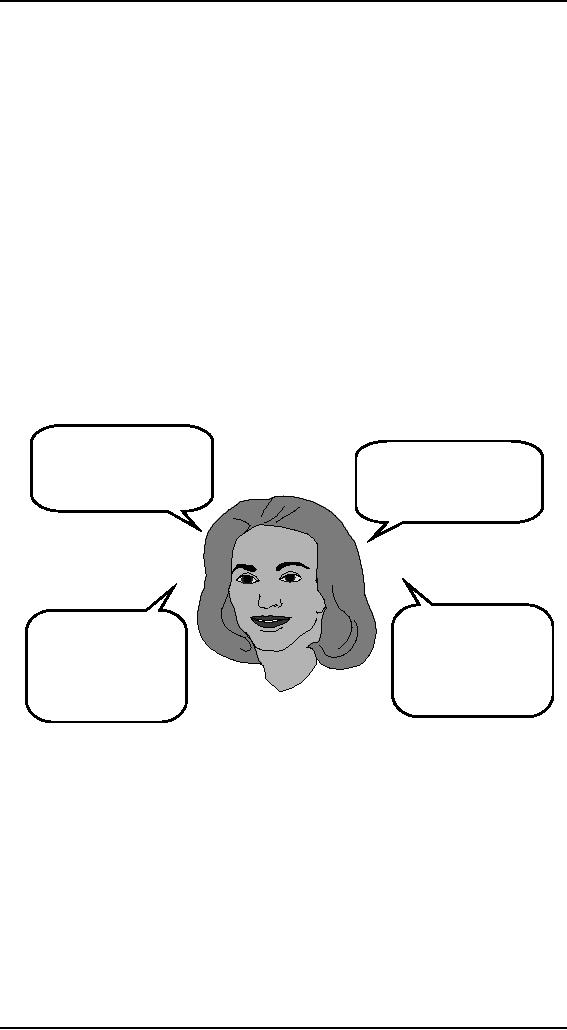 |
COGNITIVE FRAMEWORKS: MODES OF COGNITION, HUMAN PROCESSOR MODEL, GOMS |
| << DISCIPLINE OF HUMAN COMPUTER INTERACTION |
| HUMAN INPUT-OUTPUT CHANNELS, VISUAL PERCEPTION >> |

Human
Computer Interaction
(CS408)
VU
Lecture
6
Lecture 6.
Cognitive
Frameworks
Learning
Goals
As the
aim of this lecture is to
introduce you the study of
Human Computer
Interaction,
so that after studying this
you will be able to:
Understand
the importance of
Cognition
�
Understand
different cognitive frameworks in
HCI
�
6.1
Introduction
Imagine
trying to drive a car by using
just a computer keyboard.
The four arrow
keys
are used
for steering, the space
bar for braking, and
the return key for
accelerating. To
indicate
left you need to press the
F1 key and to indicate right
the F2 key. To sound
your
horn you need to press the
F3 key. To switch the
headlights on you need to
use
the F4
key and, to switch the
windscreen wipers on, the F5
key. Now imagine as
you
are
driving along a road a ball
is suddenly kicked in front of
you. What would you
do?
Bash the
arrow keys and the
space bar madly while
pressing the F4 key? How
would
rate
your chance of missing the
ball?
Most of
us would bald at the very
idea of driving a car this
way. Many early
video
games,
however, were designed along
these lines: the user
had to press an
arbitrary
combination
of function keys to drive or
navigate through the game.
More recently,
computer
consoles have been designed with
the user's capabilities and
demands of the
activity
in ming. Much better way of
controlling and interacting,
such as through
using
joysticks and steering
wheels, are provided that
map much better onto
the
physical
and cognitive aspects of
driving and
navigating.
We have
to understand the limitations of
the people to ease them.
Let us see what is
cognitive
psychology and how it helps
us.
Cognitive
Psychology
Psychology
is concerned primarily with understanding
human behavior and
the
mental
processes that underlie it.
To account for human behavior,
cognitive
psychology
has adopted the notion of
information processing. Everything we
see, feel,
touch,
taste, smell and do is couched in
terms of information processing.
The
objective
cognitive psychology has been to
characterize these processes in terms
of
their
capabilities and limitations.
For example, one of the
major preoccupations of
cognitive
psychologists in the 1960s
and 1970s was identifying
the amount o f
information
that could be processed and
remembered at any one time.
Recently,
alternative
psychological frameworks have been
sought which more
adequately
characterize
the way people work
with each other and
with the various
artifacts,
including
computers, that they have
use. Cognitive psychology
have attempted to
apply
relevant psychological principles to HCI
by using a variety of
methods,
46

Human
Computer Interaction
(CS408)
VU
including
development of guidelines, the
use of models to predict
human performance
and
the use of empirical methods
for testing computer
systems.
Cognition
The
dominant framework that has
characterized HCI has been cognitive.
Let us define
cognition
first:
Cognition
is what goes on in out heads
when we carry out our
everyday activities.
In
general, cognition refers to the
processes by which we become acquainted
with
things
or, in other words, how we
gain knowledge. These include
understanding,
remembering,
reasoning, attending, being
aware, acquiring skills and
creating new
ideas.
As figure
indicates there are
different kinds of
cognition.
What goes on in
the mind?
perceiving..
thinking..
understanding
others
remembering..
talking with
others
learning..
manipulating
others
planning a
meal
making
decisions
imagining a
trip
solving
problems
painting
daydreaming...
writing
composing
The
main objective in HCI has been to
understand and represent how
human interact
with
computers in term of how knowledge is
transmitted between the two.
The
theoretical
grounding for this approach
stems from cognitive
psychology: it is to
explain
how human beings achieve
the goals they
set.
Cognition
has also been described in terms of
specific kinds of processes.
These
include:
� Attention
� Perception
and recognition
� Memory
� Learning
� Reading,
speaking, and
listening
� Problem
solving, planning, reasoning,
decision-making.
47

Human
Computer Interaction
(CS408)
VU
It is
important to note that many
of these cognitive processes
are interdependent:
several
may be involved for a given
activity. For example, when
you try to learn
material
for an exam, you need to
attend the material,
perceive, and recognize it,
read
it,
think about it, and
try to remember it. Thus
cognition typically involves a range
of
processes.
It is rare for one to occur in
isolation.
6.2
Modes of
Cognition
Norman
(1993) distinguishes between
two general modes:
1.
Experiential cognition
2.
Reflective cognition
Experiential
cognition
It is the
state of mind in which we
perceive, act, and react to events around
us
effectively
and effortlessly. It requires
reaching a certain level of
expertise and
engagement.
Examples include driving a car,
reading a book, having a
conversation,
and
playing a video game.
Reflective
cognition
Reflective
cognition involves thinking,
comparing, and decision-making.
This kind of
cognition
is what leads to new ideas and
creativity. Examples include
designing,
learning,
and writing a book.
Norman
points out that both
modes are essential for everyday
life but that
each
requires
different kinds of technological
support.
Information
processing
One of
the many other approaches to
conceptualizing how the mind
works, has been
to use
metaphors and analogies. A number of
comparisons have been made,
including
conceptualizing
the mind as a reservoir, a
telephone network, and a
digital computer.
One
prevalent metaphor from
cognitive psychology is the
idea that the mind is
an
information
processor.
During
the 1960s and 1970s
the main paradigm in
cognitive psychology was
to
characterize humans as
information processors; everything
that is sensed
(sight,
hearing,
touch, smell, and taste) was
considered to be information, which
the mind
processes.
Information is thought to enter
and exit the mind
through a series of
ordered
processing stages. As shown in figure,
within these stages, various
processes
are
assumed to act upon mental
representations. Processes include
comparing and
matching.
Mental representations are
assumed to comprise images, mental
models,
rules,
and other forms of
knowledge.
Output
Input
Response
Response
Encoding
Comparison
or
or
execution
Selection
response
stimuli
Stage
1
Stage
2
Stage
3
Stage
4
Stage1
encodes information from the
environment into some form
of internal
representation.
In stage 2, the internal
representation of the stimulus is
compared with
memorized
representations that are stored in
the brain. Stage 3 is
concerned with
48

Human
Computer Interaction
(CS408)
VU
deciding
on a response to the encoded stimulus.
When an appropriate match is
made
the
process passes on to stage 4,
which deals with the
organization of the response
and
the
necessary action. The model
assumes that information is
unidirectional and
sequential
and that each of the
stages takes a certain amount of
time, generally
thought
to depend on the complexity of
the operation
performed.
To
illustrate the relationship
between the different stages
of information processing,
consider
the sequence involved in
sending mail. First, letters
are posted in a mailbox.
Next, a
postman empties the letters
from the mailbox and takes
them to central
sorting
office.
Letters are then sorted according to
area and sent via
rail, road, air or ship
to
their
destination. On reaching their
destination, the letters are
further forted into
particular
areas and then into street
locations and so on. A major
aspect of an
information
processing analysis, likewise, is tracing
the mental operations and
their
outcomes
for a particular cognitive
task. For example, let us
carry out an
information
processing
analysis for the cognitive
task of determining the
phone number of a
friend.
Firstly,
you must identify the words
used in the exercise. Then
you must retrieve
their
meaning.
Next you must understand the
meaning of the set of words
given in the
exercise.
The next stage involves
searching your memory for
the solution to the
problem.
When you have retrieved
the number in memory, you
need to generate a
plan
and formulate the answer
into a representation that
can be translated into a
verbal
form.
Then you would need to
recite the digits or write
them down.
Extending
the human information processing
model
Two
main extensions of the basic
information-processing model are
the inclusion of
the
processes of attention and
memory. Figure shows the
relationship between
the
different
processes. [3]
Attention
Encoding
Comparison
Response
Response
Selection
Execution
Memory
In the
extended model, cognition is
viewed in terms of:
1. how
information is perceptual
processors
2. how
that information is attended
to, and
3. how
that information is processed
and stored in memory.
49

Human
Computer Interaction
(CS408)
VU
6.3
Human
processor model
The
information-processing model provides a
basis from which to make
predictions
about
human performance. Hypotheses
can be made about how long
someone will
take to
perceive and responds to a
stimulus (also known as
reaction time) and
what
bottlenecks
occur if a person is overloaded with
too much information. The
best-
known
approach is
the
human processor model, which
models the cognitive
processes of a user
interacting
with a computer. Based on
the information-processing model,
cognition is
conceptualized
as a series of processing stages where
perceptual, cognitive,
motor
processors
are organized in relation to
one another. The model
predicts which
cognitive
processes are involved when
a user interacts with a
computer, enabling
calculations
to be made how long a user
will take to carry out
various tasks. This
can
be very
useful when comparing
different interfaces. For
example, it has been used
to
compare
how well different word
processors support a range of editing
tasks.
The
information processing approach is based
on modeling mental activities
that
happen
exclusively inside the head.
However, most cognitive activities
involve people
interacting
with external kinds of
representations, like books, documents,
and
computers--not
to mentions one another. For
example, when we go home
from
wherever
we have been we do not need to remember
the details of the route
because
we rely
on cues in the environment
(e.g., we know to turn left
at the red house,
right
when
the road comes to a
T-junction, and so on.).
Similarly, when we are at home
we
do not
have to remember where
everything is because information is
"out there." We
decide
what to eat and drink by
scanning he items in the
fridge, find out whether
any
messages
have been left by glancing at
the answering machine to see
if there is a
flashing
light, and so on.
[2]
6.4
GOMS
Card et
al. have abstracted a further
family of models, known as
GOMS (goals,
operations,
methods and selection rules)
that translate the
qualitative descriptions
into
quantitative
measures. The reason for
developing a family of models is
that it enables
various
qualitative and quantitative
predictions to be made about
user performance.
Goals
These are
the user's goals, describing
what the user wants to
achieve. Further, in
GOMS
the goals are taken to
represent a `memory point' for
the user, from which
he
can
evaluate what should be done
and to which he may return
should any errors
occur.
[1]
Operators
These are
the lowest level of
analysis. They are the basic
actions that the user
must
perform
in order to use the system.
They may affect the
system (e.g., press the
`X'
key) or
only the user's mental
state (e.g., read the
dialogue box). There is
still a
degree of
flexibility about the
granularity of operators; we may
take the command
level
"issue the select command" or be
more primitive; "move mouse
to menu bar,
press
center mouse button...."
[1]
50

Human
Computer Interaction
(CS408)
VU
Methods
As we
have already noted, there
are typically several ways in
which a goal can be
split
into sub goals.
[1]
Selection
Selection
means of choosing between
competing methods [1]
One of
the problems of abstracting a
quantitative model from a
qualitative description
of user
performance is ensuring that
two are connected. In particular, it a
has been
noted
that the form and contents
of GOMS family of models are
relatively unrelated
to the
form and content of the
model human processor and it
also oversimplified
human
behavior. More recently,
attention has focused on
explaining:
Knowledge
Representation Models
�
How
knowledge is represented
Mental
Models
�
How
mental models (these refer
to representation people construct in
their
mind of
themselves, others, objects and
the environment to help them
know
what to
do in current and future
situations) develop and are
used in HCI
User
Interaction Learning
Models
�
How
user learn to interact and
become experienced in using computer
system.
With
respect to applying this
knowledge to HCI design, there
has been considerable
research
in developing:
Conceptual
Models
Conceptual
models are (these are
the various ways in which
systems are understood
by
different people) to help designers
develop appropriate
interfaces.
Interface
Metaphor
Interface
metaphors are (these are GUIs
that consists of electronic
counterparts to
physical
objects in the real world)
to match the knowledge
requirements of users.
6.5
Recent
development in cognitive
psychology
With
the development of computing,
the activity of brain has
been characterized as a
series of
programmed steps using the
computer as a metaphor. Concept
such as
buffers,
memory stores and storage
systems, together with the
type of process that
act
upon
them (such as parallel verses
serial, top-down verses
down-up) provided
psychologist
with a mean of developing more
advanced models of
information
processing,
which was appealing because
such models could be tested.
However,
since the
1980s there has been a more
away from the
information-processing
framework
with in cognitive psychology.
This has occurred in
parallel with the
reduced
importance of the model
human processor with in HCI
and the development
other
theoretical approaches. Primarily, these
are the computational and
the
connectionist
approaches. More recently other
alternative approaches have been
developed
that has situated cognitive
activity in the context in
which they occur.
[3]
51

Human
Computer Interaction
(CS408)
VU
Computational
Approaches
Computational
approaches continue to adopt the
computer metaphor as a
theoretical
framework,
but they no longer adhere to
the information-processing
framework.
Instead,
the emphasis is on modeling
human performance in terms of
what is involved
when
information is processed rather
than when and how
much. Primarily,
computational
models conceptualize the
cognitive system in terms of the
goals,
planning
and action that are
involved in task performance.
These aspects include
modeling:
how information is organized
and classified, how relevant
stored
information
is retrieved, what decisions
are made and how
this information is
reassemble.
Thus tasks are analyzed not
in terms of the amount of
information
processed
per se in the various stages
but in terms of how the
system deals with new
information.
[3]
Connectionist
Approaches
Connectionist
approaches, otherwise known as neural
networks or parallel
distributed
processing,
simulate behavior through
using programming models.
However, they
differ
from conceptual approaches in that
they reject the computer
metaphor as a
theoretical
framework. Instead, they
adopt the brain metaphor, in
which cognition is
represented at
the level of neural networks
consisting of interconnected nodes.
Hence
all
cognitive processes are
viewed as activations of the
nodes in the network and
the
connections
between them rather than
the processing and manipulation
of
information.
[3]
6.6
External
Cognition
External
cognition is concerned with explaining
the cognitive processes
involved
when we
interact with different
external representations. A main
goal is to explicate
the
cognitive benefits of using
different representations for
different cognitive
activities
and the processes involved.
The main one
include:
1.
externalizing to reduce memory
load
2.
computational offloading
3.
annotating and cognitive
tracing.
Externalizing
to reduce memory load
A number
of strategies have been developed for
transforming knowledge into
external
representations
to reduce memory load. One
such strategy is externalizing
things we
find
difficult to remember, such as
birthdays, appointments and
addresses.
Externalizing,
therefore, can help reduce
people's memory burden
by:
� reminding
them to do something (e.g., to
get something for their
mother's
birthday)
� reminding
them of what to do (e.g., to
buy a card)
� reminding
them of when to do something (send it by
a certain date)
Computational
offloading
Computational
offloading occurs when we
use a tool or device in
conjunction with an
external
representation to help us carry
out a computation. An example is
using pen or
paper to
solve a math
problem.[2]
52

Human
Computer Interaction
(CS408)
VU
Annotating
and cognitive tracing
Another
way in which we externalize
our cognitions is by modifying
representations
to
reflect changes that are
taking place that we wish
to mark. For example,
people
oftern
cross thinks off in to-do
list to show that they
have been completed. They
may
also
reorder objects in the
environment, say by creating
different piles as the
nature of
the
work to be done changes.
These two kinds of
modification are called
annotating
and
cognitive tracing:
� Annotating
involves modifying external
representations, such as crossing
off
underlining
items.
� Cognitive
tracing involves externally
manipulating items different orders
or
structures.
Information
Visualization
A general
cognitive principle for
interaction design based on
the external
cognition
approach
is to provide external representations at
the interface that reduce
memory
load
and facilities computational
offloading. Different kinds of
information
visualizations
can be developed that reduce
the amount of effort
required to make
inferences
about a given topic (e.g.,
financial forecasting, identifying
programming
bugs). In
so doing, they can extend or
amplify cognition, allowing
people to perceive
and do
activities tat they couldn't
do otherwise. [2]
6.7
Distributed
cognition
Distributed
cognition is an emerging theoretical
framework whose goal is to
provide
an
explanation that goes beyond
the individual, to conceptualizing
cognitive activities
as
embodied and situated within
the work context in which
they occur. Primarily,
this
involves
describing cognition as it is distributed
across individuals and the
setting in
which it
takes place. The collection of
actors (more generally
referred to just as
`people'
in other parts of the text),
computer systems and other
technology and their
relations
to each other in environmental
setting in which they are
situated are referred
to as
functional systems. The
functional systems that have
been studied include
ship
navigation,
air traffic control,
computer programmer teams
and civil engineering
practices.
A main
goal of the distributed
cognition approach is to analyze
how the different
components
of the functional system are
coordinated. This involves
analyzing how
information
is propagated through the
functional system in terms of
technological
cognitive,
social and organizational
aspects. To achieve this,
the analysis focuses
on
the
way information moves and
transforms between different
representational states
of the
objects in the functional
system and the consequences
of these for subsequent
actions.[3]
References:
[1]
Human Computer Interaction by
Alan Dix
[2]
Interaction Design by Jenny
Preece
[3]
Human Computer Interaction by
Jenny Preece
53
Table of Contents:
- RIDDLES FOR THE INFORMATION AGE, ROLE OF HCI
- DEFINITION OF HCI, REASONS OF NON-BRIGHT ASPECTS, SOFTWARE APARTHEID
- AN INDUSTRY IN DENIAL, SUCCESS CRITERIA IN THE NEW ECONOMY
- GOALS & EVOLUTION OF HUMAN COMPUTER INTERACTION
- DISCIPLINE OF HUMAN COMPUTER INTERACTION
- COGNITIVE FRAMEWORKS: MODES OF COGNITION, HUMAN PROCESSOR MODEL, GOMS
- HUMAN INPUT-OUTPUT CHANNELS, VISUAL PERCEPTION
- COLOR THEORY, STEREOPSIS, READING, HEARING, TOUCH, MOVEMENT
- COGNITIVE PROCESS: ATTENTION, MEMORY, REVISED MEMORY MODEL
- COGNITIVE PROCESSES: LEARNING, READING, SPEAKING, LISTENING, PROBLEM SOLVING, PLANNING, REASONING, DECISION-MAKING
- THE PSYCHOLOGY OF ACTIONS: MENTAL MODEL, ERRORS
- DESIGN PRINCIPLES:
- THE COMPUTER: INPUT DEVICES, TEXT ENTRY DEVICES, POSITIONING, POINTING AND DRAWING
- INTERACTION: THE TERMS OF INTERACTION, DONALD NORMAN’S MODEL
- INTERACTION PARADIGMS: THE WIMP INTERFACES, INTERACTION PARADIGMS
- HCI PROCESS AND MODELS
- HCI PROCESS AND METHODOLOGIES: LIFECYCLE MODELS IN HCI
- GOAL-DIRECTED DESIGN METHODOLOGIES: A PROCESS OVERVIEW, TYPES OF USERS
- USER RESEARCH: TYPES OF QUALITATIVE RESEARCH, ETHNOGRAPHIC INTERVIEWS
- USER-CENTERED APPROACH, ETHNOGRAPHY FRAMEWORK
- USER RESEARCH IN DEPTH
- USER MODELING: PERSONAS, GOALS, CONSTRUCTING PERSONAS
- REQUIREMENTS: NARRATIVE AS A DESIGN TOOL, ENVISIONING SOLUTIONS WITH PERSONA-BASED DESIGN
- FRAMEWORK AND REFINEMENTS: DEFINING THE INTERACTION FRAMEWORK, PROTOTYPING
- DESIGN SYNTHESIS: INTERACTION DESIGN PRINCIPLES, PATTERNS, IMPERATIVES
- BEHAVIOR & FORM: SOFTWARE POSTURE, POSTURES FOR THE DESKTOP
- POSTURES FOR THE WEB, WEB PORTALS, POSTURES FOR OTHER PLATFORMS, FLOW AND TRANSPARENCY, ORCHESTRATION
- BEHAVIOR & FORM: ELIMINATING EXCISE, NAVIGATION AND INFLECTION
- EVALUATION PARADIGMS AND TECHNIQUES
- DECIDE: A FRAMEWORK TO GUIDE EVALUATION
- EVALUATION
- EVALUATION: SCENE FROM A MALL, WEB NAVIGATION
- EVALUATION: TRY THE TRUNK TEST
- EVALUATION – PART VI
- THE RELATIONSHIP BETWEEN EVALUATION AND USABILITY
- BEHAVIOR & FORM: UNDERSTANDING UNDO, TYPES AND VARIANTS, INCREMENTAL AND PROCEDURAL ACTIONS
- UNIFIED DOCUMENT MANAGEMENT, CREATING A MILESTONE COPY OF THE DOCUMENT
- DESIGNING LOOK AND FEEL, PRINCIPLES OF VISUAL INTERFACE DESIGN
- PRINCIPLES OF VISUAL INFORMATION DESIGN, USE OF TEXT AND COLOR IN VISUAL INTERFACES
- OBSERVING USER: WHAT AND WHEN HOW TO OBSERVE, DATA COLLECTION
- ASKING USERS: INTERVIEWS, QUESTIONNAIRES, WALKTHROUGHS
- COMMUNICATING USERS: ELIMINATING ERRORS, POSITIVE FEEDBACK, NOTIFYING AND CONFIRMING
- INFORMATION RETRIEVAL: AUDIBLE FEEDBACK, OTHER COMMUNICATION WITH USERS, IMPROVING DATA RETRIEVAL
- EMERGING PARADIGMS, ACCESSIBILITY
- WEARABLE COMPUTING, TANGIBLE BITS, ATTENTIVE ENVIRONMENTS